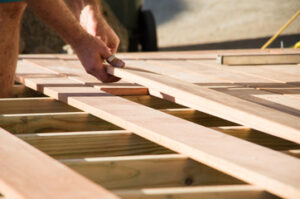Deck building is a big job and one that should be done correctly. This will ensure that the deck is up to code and safe to use. It will also help avoid any injuries that might occur due to the structure collapsing or other issues. For professional help, contact Deck Builder Stafford.

Fasten concealed-flange double joist hangers to each end of the ledger, then nail it flush with the house using joist hanger nails. Set up batter boards and mason’s strings to mark footing locations at outside corners and 8-foot intervals along the front rim joist.
Sturdy deck railings are a safety feature for raised decks, and required by code on all those 30 inches or more above grade. They help prevent falls, and add to the aesthetic appeal of a well-designed deck. Adding a railing is an easy project for most homeowners with some basic carpentry skills. There are a number of options for materials and installation, including pre-assembled railing kits. Vinyl and composite railing systems are popular for their durability and low maintenance. Iron and aluminum railings also are available, although these may require more frequent cleaning and maintenance. Regardless of what type of material you choose for your deck railing, be sure to follow local building codes for height and strength requirements, as well as the minimum size of gaps that must be in the railing to prevent small children from squeezing through.
The first step in building a deck rail is to construct the 4×4 rail posts that will hold the 2×4 balusters (or pickets). Start by cutting these to the desired length. Then measure the distance between the posts to determine how long to cut each of the 2×4 rail sections that will make up the top and bottom of the railing. Cut the top and bottom rails to this length, then mark where on the rail post the baluster layout marks will land.
Once the posts are cut, install them with a ledger, which is attached to the side of the house and to the joists that support the subflooring of your deck. This is the strongest and safest way to attach a deck to the house, and will allow you to add a roof or other structures later.
Another option, gaining in popularity, is to use special framing connectors to reinforce the connection between the posts and the rim joists. These can be fastened with lag bolts or with screws, and provide a strong and code-compliant connection.
Finally, consider adding a drink rail, which provides a flat surface on the top of the railing for people to rest their drinks or other items, like planters. This is a simple addition that can make your deck feel more welcoming to guests and families with kids and pets.
Stairs
Stairs are a key component of deck building and must meet certain code requirements. They must be safe for people to use and sturdy enough to withstand force. To ensure this, they need to be built from materials that are invulnerable to warping and rot. One of the most durable and attractive materials for stairs is steel. Its strong and durable construction allows for a wide range of styles and shapes. Steel also offers excellent longevity, even when used in outdoor conditions. To learn more about the benefits of using steel for your stairway, contact a deck contractor.
To determine the dimensions of your stair, first measure the distance from the bottom of the deck to where you want the steps to end. Then subtract the number of risers from the total run measurement to get the length of each tread. To create a comfortable staircase, the number of risers must be equal to or greater than the number of treads.
Once you have the length of each step, you can mark the pattern for the stair stringers on 2 x 12s by setting a framing square on the board and marking vertical plumb lines at the height of the risers and the length of the run. Next, cut the boards to length and screw them to the rim or end joists of your deck with approved fascia screws spaced 9 inches apart.
The outermost stringers are secured to the deck using L-brackets. Then space any intermediate stringers evenly between the outer ones, if applicable. For safety, Silva recommends spacing the intermediate stringers no more than 16 inches apart.
Next, attach the bottom of the support stringer to the deck using galvanized metal brackets. This method ensures a solid connection and will keep the stringer dry. It’s best to do this from the top of the stairway, where the deck is a little lower than the ground.
Finally, install the stair treads. When cutting the treads, make sure they are long enough to leave a small overhang at the front of the stair, and use decking screws to secure them in place. For a more finished look, consider using composite or hardwood treads with a decorative profile, such as a bullnose or radius.
Decking
A deck can be made from a wide range of materials, including wood and composites. The material you choose depends on your personal preference, maintenance preferences and budget. It is also important to consider local zoning and building codes. A professional contractor can help you determine the best materials and layout for your deck.
When selecting materials for a deck, choose durable, low-maintenance material that will stand up to weather and traffic. For example, a concrete-and-wood-mix deck is resistant to both heat and cold. It is a great choice for pool decks and other areas where there is frequent activity. You should also consider how the deck will be used and what maintenance is necessary to keep it looking good.
You should make sure the deck is properly connected to the house. Depending on the area of the country you live in, your deck may need to be secured to the home with connectors called lateral load ties. These ties are necessary for safety and to prevent damage to the house. The deck must also be attached to the foundation with bolts or screws, not nails, so it will not pull away from the house.
The foundation of a deck is often made of concrete, and it is vital to the structure of the deck. The concrete footings support the deck and distribute its weight evenly so that it will not become unstable or collapse. Footings should be poured before the framing begins. They should extend below the frost line, which varies geographically, to prevent shifting of the concrete during freeze-thaw cycles.
In addition to the structural elements of the deck, you will need a variety of hardware and accessories. For example, you will need shear studs (sometimes known as Nelson studs) to hold the beams in place. You will also need joist hangers to connect the joists to the ledger board. For the joists to be stable, they must be supported on all sides. This is done with a system of supports known as blocking, which is usually installed along the perimeter of the deck.
Deck Contractors
When you hire a contractor, it’s important to find one who is honest and will give you an estimate before the work begins. Ask about their experience, licenses and insurance coverage. If they’re insured, they will be able to compensate you in the event of damage or injury during your project. Also, find out how long it will take to complete the job and if they can provide you with a definite completion date. Construction work can be unpredictable and it’s important to find out what will happen if your deck builder has to delay the project.
Look for a contractor who uses a professional design process that includes an initial trip to your home and meeting with you to discuss your vision and determine your needs. Ask if they have photos of their previous projects or samples of materials to help you envision your new deck. Evaluate their website and social media for testimonials from satisfied customers. A reputable deck builder will want to highlight their best work and be proud of the work they do for their clients.
Ask about their payment terms and whether they require a deposit upfront. If they do, how much is required and why. Many states have laws in place to protect homeowners from contractors who demand too much money up front. Inquire about their building permit and HOA approval processes and whether they’ll handle all the necessary paperwork for you.
Check if the contractor will be working during your desired season for deck construction. Keep in mind that good deck builders are often busy during the spring and summer when temperatures are warmest. Also, ask about how they deal with inclement weather and unexpected delays.
Find out if the company has a dedicated salesperson to address your questions, concerns and requests. Some contractors assign a designer or project manager to communicate with you while others have a team of people who each specialize in specific aspects of the deck-building process. You’ll want to find a contractor who will take the time to listen to your ideas, explain their process and answer your questions.






